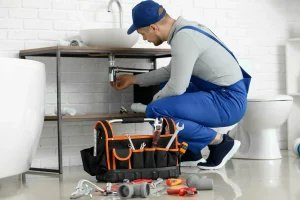Plumbing and HVAC systems are the backbone of any comfortable home. Proper maintenance ensures running…
How to Repair a Water Leak in a Wall — Expanded Guide for Daniele Emergency Plumber
 Water leaking through a wall or ceiling is urgent. It ruins plaster, breeds mould, risks electrical short-circuits, and can hide a much bigger problem. This guide covers pipe leak repair UK, providing a straightforward, expanded approach your customers can use — what to do immediately, how to attempt safe temporary repairs, how permanent fixes differ by material, and when to stop DIY and call Daniele Emergency Plumber.
Water leaking through a wall or ceiling is urgent. It ruins plaster, breeds mould, risks electrical short-circuits, and can hide a much bigger problem. This guide covers pipe leak repair UK, providing a straightforward, expanded approach your customers can use — what to do immediately, how to attempt safe temporary repairs, how permanent fixes differ by material, and when to stop DIY and call Daniele Emergency Plumber.
Read this once. Act fast. Don’t guess.
Safety — do this first
- Turn off the mains water supply immediately. If you can’t find it, turn off the nearest stopcock.
- Cut power to the affected area at the fusebox if water has reached sockets, switches, lights or wiring. Water + electricity kills. If in doubt, isolate the whole property.
- Protect belongings. Move furniture, electronics and rugs away. Put a bucket under drips and towels under wet plaster.
- Ventilate the area to slow mould growth, but don’t use heat guns on wet plaster — you’ll crack it.
- If the ceiling is bulging or sagging, evacuate the area beneath it — it can collapse.
Quick diagnostic checklist — find what you’re dealing with
Look for:
- Fresh damp patch with a clear drip = likely an active pipe leak.
- Browning stains or peeling paint = slow long-term leak or condensation.
- Bulging ceiling or saturated plaster = sustained leak; possible structural risk.
- Musty smell or visible mould = prolonged moisture, possible hidden spread.
- A sound of running water behind a wall = active hidden leak.
If the source is visible and small, keep reading. If the source is hidden, large, or near electrics/structural elements — call pro now.
Tools & materials you might need
(Only grab what you know how to use.)
- Adjustable wrench, pipe cutter or hacksaw
- Wire brush, sandpaper, clean rags
- Rubber sleeve / flexible pipe section + jubilee (hose) clamps
- Push-fit connectors (quick and safe for many DIYers)
- Epoxy putty / two-part resin for cold repairs
- Propane torch, flux and solder only if you’re experienced with copper soldering
- Bucket, towels, dust sheet, plastic sheeting
Push-fit fittings are the easiest and safest for DIY on copper/PEX/plastic. Don’t use a torch if there’s plaster dust or flammable material nearby.
Temporary fixes (stop the damage now — not forever)
- Isolate the water (mains off) and drain the run by opening the nearest tap.
- Expose the pipe enough to apply a repair (you may need to chip plaster).
- Rubber sleeve and clamps: Slide a rubber repair sleeve or short piece of flexible hose over the leak and tighten with two jubilee clips (one each side of damage).
- Epoxy putty: For small cracks, knead the putty and press it over the cleaned, dry area; follow curing times.
- Test: Slowly restore water and watch for drips. If it holds — good. Get a permanent repair within 24–72 hours.
Temporary fixes can buy time. They are not permanent and may fail, especially under pressure or temperature changes.
Permanent repairs — what actually fixes it
Which method you use depends on the pipe material and the damage.
Copper pipe:
- Best: cut out damaged section and install a push-fit coupling or soldered sleeve.
- Soldering (hot) works but needs experience — flux, correct heat, and a clean joint are musts. If unsure, use push-fit instead.
PEX / plastic pipe:
- Replace the damaged section and use compatible fittings (crimp, clamp or push-fit). Solvent welding applies to some plastics (follow manufacturer instructions).
Threaded joints:
- Replace washers or the faulty fitting. Clean, re-seal with PTFE tape or replace the joint.
Routed/embedded pipes (behind walls/floors):
- Often best handled by a pro — they may reroute the pipe or use specialist repair couplings without major demolition.
After any permanent repair: pressure-test the system, then fully dry and repair plaster/cosmetics.
Hidden leaks — how we find them (why call us)
Hidden leaks can eat your home’s structure. Professionals use:
- Acoustic leak detection (listening for water sounds)
- Thermal imaging cameras to spot wet areas
- Moisture meters to map affected zones
- Trace dye or CCTV pipe inspection for complex systems
If you can’t find the leak or it’s behind finished surfaces, call Daniele Emergency Plumber — we locate and fix hidden leaks with minimal damage.
When to stop DIY and call Daniele Emergency Plumber
Call us immediately for pipe leak repair UK if:
-
You have continuous leaking that won’t stop even when the mains water is closed.
-
The ceiling is bulging, or plaster is falling.
-
Water is near electrics, fuseboxes, or major appliances.
-
You detect a smell of gas (separate emergency) or notice structural movement/cracks.
-
The leak is hidden and you can’t locate it.
-
You lack the tools, experience, or confidence to safely perform the repair.
At Daniele Emergency Plumber, we provide 24/7 pipe leak repair UK, handling emergency shut-offs, leak detection, permanent repairs, rerouting, and full clean-up — keeping your home safe and damage-free.
What to expect when we arrive
- Quick safety assessment and water isolation.
- Leak detection and a clear explanation of the problem and repair options.
- A written or verbal estimate before work starts (we’ll explain urgency vs. permanent work).
- We’ll repair the plumbing to trade standards and test under pressure.
- We can coordinate plastering, anti-mould treatment and cosmetic repair or advise trusted trades.
- If needed, we provide documentation for insurers.
Prevention & maintenance tips
- Insulate exposed pipes in cold areas to avoid frost cracking.
- Check under sinks, behind appliances and in lofts regularly.
- If you’re leaving a property empty in winter, drain down or keep it heated.
- Fit water leak alarms in high-risk areas (under boilers, washing machines).
- Schedule routine checks if your property is older or has pipework from previous centuries.
FAQ — short answers
| Question | Answer |
|---|---|
| Can I just patch it and forget it? | No. Temporary patches can fail and hide a worsening problem. Get a permanent repair ASAP. |
| Is soldering necessary? | Not always. Push-fit connectors often do the job faster and safer for most situations. |
| |

